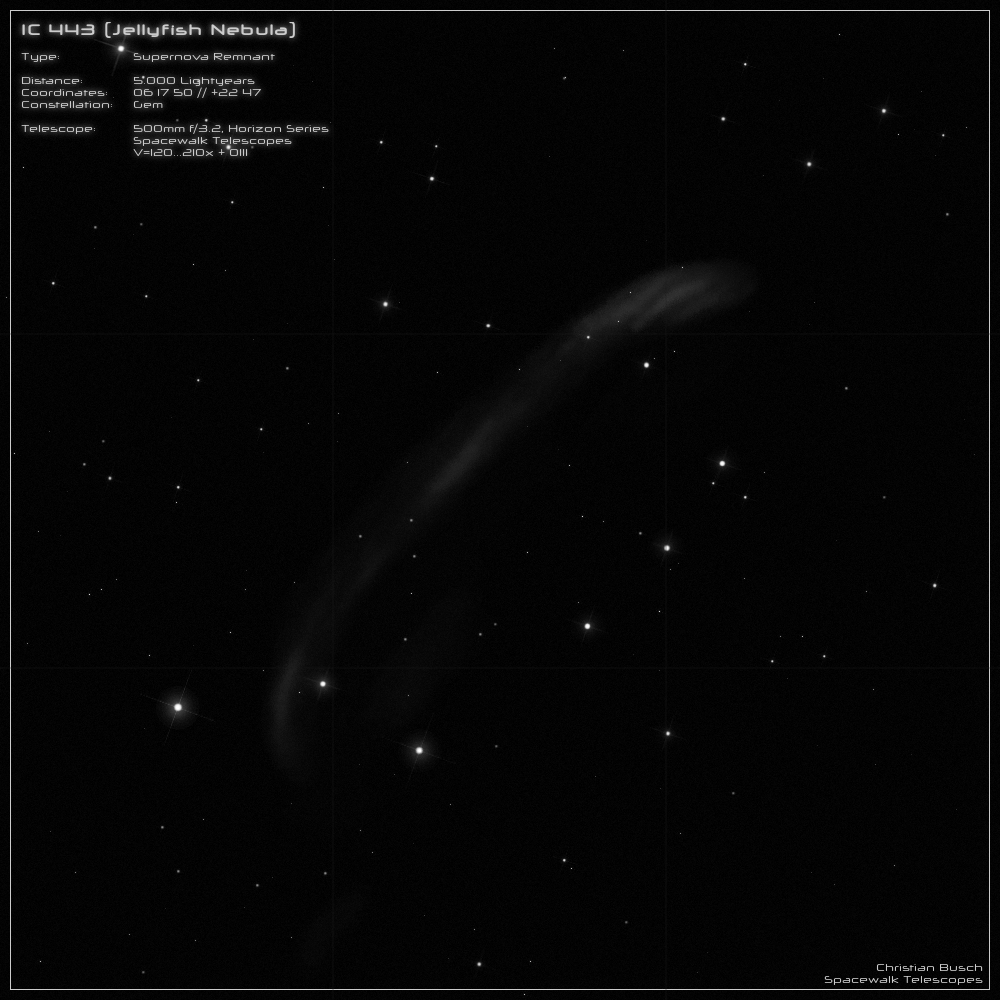IC 443 - Jellyfish Nebula
The "Jellyfish Nebula" with the catalog designation "IC 443" is a supernova remnant (SNR) that can be found at a distance of about 5,000 light-years in
the constellation Gemini. It was first discovered in 1892 on photographic plates by the German astronomer Max Wolf. The apparent brightness of IC
443 is given with 12mag, the extent with 50x40' - so the SNR appears even larger than the full moon.
The structure of IC 443 is relatively complex, because it is situated (like many other SNR) near a dense molecular cloud. It consists of two nested shells
with a total diameter of 70 light-years. In the southern part there is another nebula generated by the pulsar and its winds (a so called plerion nebula). A dark
area runs through the middle of the shell from NW to SE - this is a dust cloud which lies in the line of sight between us and the SNR and therefore hides some
parts of the glowing gas masses behind it.
In the southeastern part, the shock wave hits a very dense molecular cloud (10,000 atoms/cm³) and was slowed down by this cloud to a velocity of only
30-40km/s. In the northeastern part, however, the speed of the shock front is still 80-100km/s, because in this region of space it runs into a wall of neutral
Hydrogen (HI) with a density of only 10-1,000 atoms/cm³.
The neutron star, which is responsible for the supernova and thus for IC 443, has the striking designation "CXOU J061705.3+222127". It is not located
in the center of the Jellyfish Nebula (as one might think), but southeast of the center. In fact it moves with a speed of 800,000 kilometers per hour
(=22km/s) in this direction. The reason for this is, that a supernova explosion is often not symmetric and the star is accelerated to a specific side.
Unfortunately, the neutron star cannot be seen visually.
----------------------------------------------------------------------------------------------------------------------------------------------
The supernova remnant IC 443 is a wonderful sight in my 20" f/3 telescope, even if it does not appear as bright as one might expect from the many great
photos. Since it is relatively large, I observed it at magnifications of 120x...210x in combination with an OIII filter.
The position can be determined very quickly, as the SNR sits right next to a prominent star formation. At first sight a long nebular filament can be seen, which
appears slightly bent at the ends. The northwestern end (top right) is relatively bright and after some time three individual filaments show up at 210x, but only
two of them are clearly visible. There is another elongated bright spot in the center of the nebula, and the southeastern end (bottom left) also appears brighter than
the arc itself.
If you know where to look, you can glimpse two very faint nebulae in the near vicinity.
The surrounding area is very rich in stars, which makes IC 443 very appealing to observe. A really beautiful and exciting object. :))

